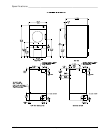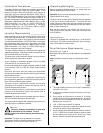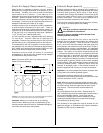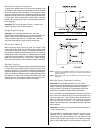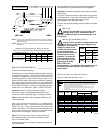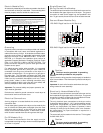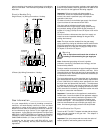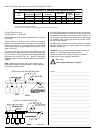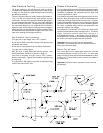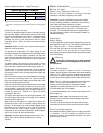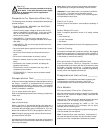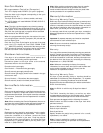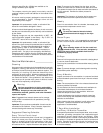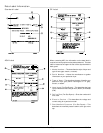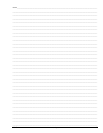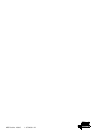
113615-1 www.amdry.com 19
Warranty tags (Part No. 450064) are available at “no
charge” from ADC upon request.
The company returning the part(s) must clearly note the
complete company name and address on the outside of the
package.
All returns must be properly packaged to ensure that they
are not damaged in transit. Damage claims are the
responsibility of the shipper.
Important: No replacements, credits, or refunds will be
issued for merchandise damaged in transit.
All returns should be shipped to the factory in such a manner
that they are insured and a proof of delivery can be obtained
by the sender.
Shipping charges are not the responsibility of ADC. All
returns should be “prepaid” to the factory. Any “C.O.D.” or
“COLLECT” returns will not be accepted.
Important: No replacements, credits, or refunds will be
issued if the claim cannot be processed due to insufficient
information. The party filing the claim will be notified in
writing, either by “FAX” or “CERTIFIED MAIL – Return
Receipt Requested,” as to the information necessary to
process claim. If a reply is not received by the Warranty
Department within 30 days from the FAX/letter date, then
no replacements, credits, or refunds will be issued, and the
merchandise will be discarded.
Routine Maintenance _________________
Cleaning
A program and/or schedule should be established for periodic
inspection, cleaning, and removal of lint from various areas
of the dryer, as well as throughout the ductwork system. The
frequency of cleaning can best be determined from
experience at each location. Maximum operating efficiency
is dependent upon proper airflow. The accumulation of lint
can restrict this airflow. If the guidelines in this section are
met, the dryer will provide many years of efficient, trouble
free, and most importantly, safe operation.
Warning
Lint from most fabrics is highly combustible.
The accumulation of lint can create a potential
fire hazard. Keep dryer area clear and free from
combustible materials, gasoline, and other flammable
vapors and liquids.
Note: Suggested time intervals shown are for average
usage, which is considered 6 to 8 operational (running)
hours per day.
Important: Dryer produces combustible lint and must be
exhausted to the outdoors. Every 6 months, inspect the
exhaust ducting and remove any lint buildup.
Suggested Cleaning Schedule
Every Third or Fourth Load
Clean the lint screen every third or fourth load. A clogged lint
screen will cause poor dryer performance. The lint door/
drawer is located just below the loading door of the dryer.
Open the lint door/drawer, brush the lint off the lint screen,
and remove the lint. Inspect lint screen and replace if torn.
Note: To remove the lint drawer from the dryer, pull the
drawer out loosen the torx screws on the sides of the rails.
This allows the metal clips to rotate and allow the drawer to
be fully removed. Reverse the above process for
installation.
Important: The frequency of cleaning the lint screen can
best be determined from experience at each location.
Weekly
Clean lint accumulation from lint chamber, thermostat, and
microprocessor temperature sensor area.
Warning
To avoid the hazard of electrical shock,
discontinue electrical supply to the dryer.
Steam Dryers
Clean the steam coil fins. It is suggested that compressed
air and a vacuum cleaner with brush attachment be used.
Warning
When cleaning steam coil fins, be careful not
to bend the fins. If fins are bent, straighten by
using a fin comb, which is available from local air-
conditioning supply houses.
90 Days
Remove lint from gas valve burner area with a dusting brush
or vacuum cleaner attachment.
Clean any lint accumulation in and around the motor(s) casing
opening.
Note: To prevent damage, avoid cleaning and/or touching
ignitor/flame-probe assembly.
Every 6 Months
Inspect and remove lint accumulation in customer furnished
exhaust ductwork system and from dryer’s internal exhaust
ducting.
Note: The accumulation of lint in the exhaust ductwork can
create a potential fire hazard.
Do not obstruct the flow of combustion and ventilation air.
Check back draft dampers in the exhaust ductwork.
Inspect and remove any lint accumulation, which can
cause the damper to bind or stick.
A back draft damper that is sticking partially closed can
result in slow drying and shutdown of heat circuit safety
switches or thermostats.
When cleaning the dryer cabinet(s), avoid using harsh
abrasives. A product intended for the cleaning of
appliances is recommended.
7 Days After Installation
and Every 12 Months Thereafter
A competent professional should inspect bolts, nuts, screws,
setscrews, grounding connections and nonpermanent gas
connections (unions, shutoff valves, and orifices). Belts
should be examined. Cracked or seriously frayed belts should
be replaced. Complete an operational check of controls and
valves. Complete an operational check of all safety devices
(lint door/drawer switch, door switches, sail switch, and
hi-limit thermostats).
!
!
!



